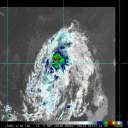Show Selection:
|
#903112 (Received by flhurricane at: 4:41 PM 14.Sep.2017)
TCDAT2
Tropical Storm Jose Discussion Number 38
NWS National Hurricane Center Miami FL AL122017
500 PM AST Thu Sep 14 2017
The cloud pattern of Jose has become more symmetric this afternoon,
with the apparent center perhaps a little more centered in the
central dense overcast. Dvorak intensity estimates, however, are
unchanged from six hours ago, so the initial wind speed remains 60
kt. Visible imagery suggest some drier air has become entrained into
the circulation of the storm, with outflow boundaries noted in the
northern semicircle. This dry air should gradually mix out while
Jose remains over warm waters with light-to-moderate shear
conditions. This environment favors some strengthening over the
next few days, and the official forecast reflects this idea, lying
between the model consensus and the global models. In the longer
term, shear is forecast to increase and water temperatures should
moderate. Therefore, some weakening is probable at days 4 and 5,
and that is reflected in the official forecast.
Jose continues to move west-northwestward, now at about 7 kt. The
storm should turn northwestward by Saturday and northward by early
Monday while it moves around a ridge over the western Atlantic
Ocean. Model guidance, however, is not in good agreement on the
strength of that ridge, leading to some significant model
differences on this cycle. The leftmost global model is the UKMET,
which moves Jose significantly farther westward than the other
guidance in the short term, leading to a closer pass of Jose to
the Outer Banks. However, most of the rest of the guidance show the
northward turn starting earlier, leading to a more offshore track.
Given the UKMET`s recent westward bias, the new NHC forecast will
put more weight on the GFS/ECMWF solutions, leading to very little
change to the previous track. It should be noted there is a fair
bit of spread in the global models and their ensembles, which does
not give me a lot of confidence in the long-term track forecast.
KEY MESSAGES:
1. Swells generated by Jose are affecting Bermuda, the Bahamas, the
northern coasts of Hispaniola and Puerto Rico, and the southeast
coast of the United States, and will spread northward along the
mid-Atlantic coast of the U.S. during the next few days. These
swells are likely to cause dangerous surf and rip current
conditions.
2. Jose could produce other direct impacts next week along portions
of the east coast of the United States from North Carolina northward
to New England, but it is too soon to determine what those impacts
might be or where they could occur. Interests along U.S. east coast
from North Carolina northward to New England should monitor the
progress of Jose during the next several days.
FORECAST POSITIONS AND MAX WINDS
INIT 14/2100Z 25.2N 67.3W 60 KT 70 MPH
12H 15/0600Z 25.6N 68.6W 60 KT 70 MPH
24H 15/1800Z 26.5N 70.3W 65 KT 75 MPH
36H 16/0600Z 27.5N 71.7W 70 KT 80 MPH
48H 16/1800Z 28.6N 72.5W 75 KT 85 MPH
72H 17/1800Z 30.7N 72.5W 80 KT 90 MPH
96H 18/1800Z 33.5N 72.0W 75 KT 85 MPH
120H 19/1800Z 36.5N 71.5W 70 KT 80 MPH
$$
Forecaster Blake |



